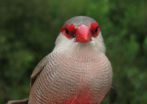(Press-News.org) Patterned feathers, previously thought to be used only for camouflage in birds, can play an important role in attracting a mate and fending off rivals, a University of Melbourne study reveals.
Ms Thanh-Lan Gluckman, co-author of the paper and Masters of Philosophy student from the Department of Zoology at the University of Melbourne, Australia, said this finding brought a new perspective to research in animal communication and evolution.
"The implication of this study is that feathers don't need to be bright and showy to be used in sexual signalling and hence this changes our understanding of animal communication," she said.
Hundreds of bird species such as Zebra Finches and Cuckoos have "barred" patterns on their feathers, which are made up of horizontal bars alternating dark and light pigmentation side by side.
"Since Darwin wrote of visual communication in birds, we have known that bright coloured feathers play a role in sexual signalling, for example to attract females. But the role of barred patterns as a communication signal has largely been overlooked," Ms Gluckman said.
The study was a large-scale comparison of plumage of around 8900 bird species worldwide (90% of all bird species), and was conducted with former University of Melbourne lecturer Dr. Gonçalo Cardoso, now at the Research Centre in Biodiversity and Genetic Resources (CIBIO), Portugal.
The researchers compared barred plumage and other patterns on the body of males, females, and juvenile birds, to assess what they might be used for.
While the researchers found evidence that barred plumage is predominantly used as camouflage, they also found that barred plumage was much more likely to appear only in males, or only at sexual maturity, compared to other patterns.
"Furthermore, we found these differences on the front of the birds, which is an important area for communication during face-to-face interactions, not on their back, which is more useful for camouflage when running away or hiding from predators," she said.
"This is an exciting finding showing an elegant evolutionary solution to the needs of birds to camouflage as well as to signal to a potential mate or rival."
INFORMATION:
The study has been published in the prestigious Journal of Evolutionary Biology.
Secrets of birds' sexual signals revealed
2010-09-20
ELSE PRESS RELEASES FROM THIS DATE:
Protein behind development of immune system sentinels identified
2010-09-20
A protein called PU.1 is essential for the development of dendritic cells, the sentinels of the immune system, Walter and Eliza Hall Institute researchers in Melbourne, Australia, have shown.
Dendritic cells (DC) are immune cells that present proteins from foreign invaders, such as viruses, to the killer T cells of the immune system, allowing a full immune response to be mounted against the invaders.
Researchers from the Immunology division have been studying dendritic cells and how different molecules regulate their development.
Dr Li Wu said one of the molecules ...
Citizen scientist
2010-09-20
We are all scientists now, thanks to SETI@home, Galaxy Zoo, The Great Sunflower Project, Folding@home and counltess other projects that allow individuals to take part in scientific research directly or indirectly. In the case of SETI@home and Folding@home one shares one's computer CPU with the researchers, whereas Galaxy Zoo is more about active involvement with the classification of stellar objects in images of the night sky, for instance.
Now, writing in the International Journal of Organisational Design and Engineering, US researchers have mapped out an approach to ...
Marine scientists unveil the mystery of life on undersea mountains
2010-09-20
They challenge the mountain ranges of the Alps, the Andes and the Himalayas in size yet surprisingly little is known about seamounts, the vast mountains hidden under the world's oceans. Now in a special issue of Marine Ecology scientists uncover the mystery of life on these submerged mountain ranges and reveal why these under studied ecosystems are under threat.
The bathymetry of our oceans is now resolved at a scale and detail unimaginable by early pioneers and recent estimates suggest that, globally, there may be up to 100,000 seamounts, yet despite best efforts less ...
Study gets measure of how best to prevent blood clots
2010-09-20
Treating hospital patients with thigh-length surgical stockings, rather than knee-high socks, can reduce life threatening blood clots, a new study suggests.
Researchers found that knee-high stockings, which are similar to flight socks, do little in stroke patients to prevent deep vein thrombosis (DVT), a life threatening form of blood clot that can travel up into the heart and lungs, .
The CLOTS (Clots in Legs Or sTockings after Stroke) study from the University of Edinburgh highlights that the clot rate in stroke patients was higher among those fitted with the shorter ...
The Amazon rainforest -- a cloud factory
2010-09-20
The forest in the Amazon Basin produces its own rain. During the wet season, aerosol particles, which serve to condensate clouds and precipitation here, mainly consist of organic material. These aerosols are released by the rainforest itself. This has been demonstrated by scientists from the Max Planck Institute for Chemistry in Mainz, who are now able to draw conclusions about the mechanisms of this ecosystem: the high content of organic material indicates that the Amazon Basin acts as a largely self-contained biogeochemical reactor during the rainy season. The results ...
Vigilant camera eye
2010-09-20
»Goal, goal, goal!« fans in the stadium are absolutely ecstatic, the uproar is enormous. So it's hardly surprising that the security personnel fail to spot a brawl going on between a few spectators. Separating jubilant fans from scuffling hooligans is virtually impossible in such a situation. Special surveillance cameras that immediately spot anything untoward and identify anything out of the ordinary could provide a solution. Researchers from the Fraunhofer Institute for Applied Information Technology FIT in Sankt Augustin have now developed such a device as part of the ...
Image sensors for extreme temperatures
2010-09-20
More and more car manufacturers are equipping their vehicles with image sensors – e.g. to register the presence of pedestrians or vehicles in the blind spot or to detect obstacles when parking. The sensors must be able to function in extremely high temperatures and in blazing sunlight. If they are installed behind the rear view mirror or on the instrument panel, for example, they can get very hot. The Fraunhofer Institute for Microelectronic Circuits and Systems IMS in Duisburg has developed a CMOS (complementary metal oxide semiconductor) image sensor for an industrial ...
Taking the pulse of coral reefs
2010-09-20
Healthy reefs with more corals and fish generate predictably greater levels of noise, according to researchers working in Panama. This has important implications for understanding the behaviour of young fish, and provides an exciting new approach for monitoring environmental health by listening to reefs.
Contrary to Jacques Cousteau's 'Silent World', coral reefs are surprisingly noisy places, with fish and invertebrates producing clicks and grunts which combine to produce cacophonies of noise. Each reef is subtly different depending on the size and composition of the ...
Earth's highest coastal mountain on the move
2010-09-20
The rocks of Colombia's Sierra Nevada de Santa Marta—the highest coastal mountain on Earth—tell a fascinating tale: The mountain collides and then separates from former super-continents. Volcanoes are born and die. The mountain travels from Peru to northern Colombia and finally rotates in a clockwise direction to open up an entirely new geological basin. Smithsonian scientists were part of a four-year project to study Santa Marta's geological evolution. Their findings are published in the October 2010 special issue of the Journal of South American Earth Sciences.
The study ...
Returning troops face both physical and mental challenges
2010-09-20
Is the US health system comprehensively meeting the needs of returning veterans? With the recent attention to mental illness in returning soldiers, and post-traumatic stress disorder (PTSD) in particular, little research has focused on the medical care needs of those returning from Operation Enduring Freedom/Operation Iraqi Freedom, according to Dr. Susan Frayne, from the VA Palo Alto Health Care System and Stanford University, and colleagues.
Their research highlights that veterans suffering from PTSD also suffer more medical illnesses than do those with no mental health ...







